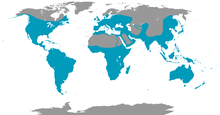
Back Coraciiformes Afrikaans Coraciiformes AN شقراقيات Arabic شقراقيات ARZ Coraciiformes AST Asutdunol (Coraciiformes) AVK Rakşikimilər Azerbaijani Ракшападобныя Byelorussian Ракшападобныя BE-X-OLD Синявицоподобни Bulgarian
| Coraciiformes Temporal range:
| |
|---|---|

| |
| European roller Coracias garrulus | |
| Scientific classification | |
| Domain: | Eukaryota |
| Kingdom: | Animalia |
| Phylum: | Chordata |
| Class: | Aves |
| Clade: | Picodynastornithes |
| Order: | Coraciiformes Forbes, 1884 |
| Families | |
|
For prehistoric taxa, see text. | |

| |
| Global distribution of the kingfisher and allies. | |
The Coraciiformes /kɒrəˈsaɪ.ɪfɔːrmiːz/ are a group of usually colourful birds including the kingfishers, the bee-eaters, the rollers, the motmots, and the todies. They generally have syndactyly, with three forward-pointing toes (and toes 3 & 4 fused at their base), though in many kingfishers one of these is missing.[citation needed] The members of this order are linked by their "slamming" behaviour, thrashing their prey onto surfaces to disarm or incapacitate them.[1]
In the past, Coraciiformes encompassed all anisodactyl (including syndactyl) members of the Cavitaves. This means that the birds currently classified in Leptosomiformes (cuckoo-roller) and Bucerotiformes (hornbills, hoopoes and allies) were formerly classified in Coraciiformes.[2]
This is largely an Old World order, with the representation in the New World limited to the dozen or so species of todies and motmots, and a mere handful of the more than a hundred species of kingfishers.
The name Coraciiformes means "raven-like". Specifically, it comes from the Latin language "corax", meaning "raven" and Latin "forma", meaning "form".[3]
- ^ "Coraciiformes". Britannica. Retrieved 13 September 2022.
- ^ Clements, J. F.; Schulenberg, T. S.; Iliff, M. J.; Roberson, D.; Fredericks, T. A.; Sullivan, B. L.; Wood, C. L. (2014). "The eBird/Clements checklist of birds of the world: Version 6.9". Archived from the original on December 17, 2014.
- ^ Terres, John K. (1980). The Audubon Society encyclopedia of North American birds (1st ed.). New York: A. A. Knopf. p. 104. ISBN 0-394-46651-9.